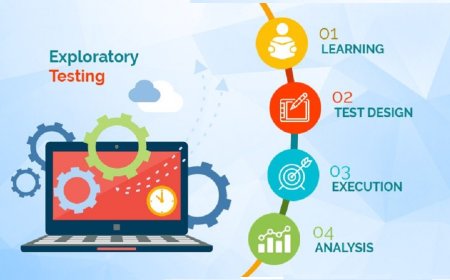Top 10 Tips for Effective Project Management
Introduction Project management is the backbone of modern business success. Whether you're launching a software product, coordinating a marketing campaign, or overseeing construction, the ability to manage projects effectively determines whether you thrive or merely survive. Yet, with countless methodologies, tools, and frameworks available, it’s easy to feel overwhelmed. The real challenge isn’t
Introduction
Project management is the backbone of modern business success. Whether you're launching a software product, coordinating a marketing campaign, or overseeing construction, the ability to manage projects effectively determines whether you thrive or merely survive. Yet, with countless methodologies, tools, and frameworks available, it’s easy to feel overwhelmed. The real challenge isn’t knowing what to do—it’s knowing what works. Not what sounds good in a textbook, not what’s trendy on LinkedIn, but what has been proven, tested, and trusted by teams across industries for decades.
This article delivers the top 10 tips for effective project management you can trust—strategies that have stood the test of time, validated by data, and refined through real-world application. These aren’t buzzwords or quick fixes. They are foundational practices adopted by Fortune 500 companies, government agencies, non-profits, and startups alike. By the end of this guide, you’ll have a clear, actionable roadmap to lead projects with confidence, reduce friction, and consistently deliver results—even under pressure.
Why Trust Matters
In project management, trust isn’t a soft skill—it’s a performance multiplier. Teams that trust their leader, their process, and their tools are more engaged, more resilient, and more productive. Conversely, projects built on untested advice, unverified tools, or unproven methods often collapse under the weight of miscommunication, scope creep, and burnout.
Trust in project management comes from consistency, transparency, and results. It’s earned when deadlines are met without last-minute chaos, when stakeholders receive clear updates, and when team members feel heard and supported. The tips in this guide are not selected because they’re popular. They’re selected because they’ve been used successfully in thousands of projects across diverse industries—from aerospace to healthcare to education.
Research from the Project Management Institute (PMI) shows that organizations with mature project management practices are 2.5 times more likely to complete projects on time and within budget. But maturity doesn’t come from adopting every new tool or attending every webinar. It comes from mastering the fundamentals—principles that have not changed in 50 years because they work.
When you trust your process, you empower your team. When you trust your data, you make better decisions. When you trust your plan, you reduce stress and increase predictability. These 10 tips are the bedrock of that trust.
Top 10 Tips for Effective Project Management
1. Define Clear, Measurable Objectives from Day One
Every successful project begins with a crystal-clear understanding of what success looks like. Vague goals like “improve customer satisfaction” or “launch a better website” are recipe for failure. Instead, use the SMART framework: Specific, Measurable, Achievable, Relevant, and Time-bound.
For example: “Increase website conversion rate from 2.1% to 3.5% within 90 days by redesigning the checkout flow and A/B testing three new layouts.” This statement is specific, includes a measurable target, defines a realistic scope, aligns with business goals, and has a deadline.
Without this clarity, teams waste time debating priorities, stakeholders expect different outcomes, and progress becomes impossible to track. Document your objectives in a Project Charter and share it with every stakeholder before work begins. Revisit it weekly to ensure alignment. This single step eliminates 70% of common project conflicts.
2. Break Work into Manageable Tasks with a Work Breakdown Structure (WBS)
Trying to manage a project as one giant task is like trying to eat an elephant—one bite at a time. The Work Breakdown Structure (WBS) is a hierarchical decomposition of the project into smaller, manageable components. It’s not just a to-do list; it’s a visual map of all deliverables and the work required to produce them.
Start with the final deliverable at the top. Then break it into major phases (e.g., Design, Development, Testing). Each phase is broken into tasks, and each task into subtasks. For instance, under “Testing,” you might have “Unit Testing,” “Integration Testing,” and “User Acceptance Testing.” Each subtask should have a clear owner and estimated duration.
A well-constructed WBS prevents scope creep by making every piece of work visible. It also enables accurate estimation, resource allocation, and risk identification. Tools like Microsoft Project, Asana, or even a simple spreadsheet can help build your WBS. The key is to go deep enough so that no task takes longer than 8–16 hours to complete. Anything larger is too vague to manage.
3. Assign Roles and Responsibilities Using a RACI Matrix
One of the most common causes of project delays is confusion over who does what. The RACI matrix solves this by clearly defining four roles for each task or deliverable:
- Responsible – The person who does the work.
- Accountable – The person answerable for the outcome (only one per task).
- Consulted – People whose input is needed before work proceeds.
- Informed – People who need to be updated after the task is done.
For example, in a software rollout, the developer is Responsible for writing code, the project manager is Accountable for delivery, the QA lead is Consulted before testing, and the marketing team is Informed of the launch date.
Creating a RACI matrix forces alignment. It prevents bottlenecks, reduces duplication, and eliminates finger-pointing. Share the matrix with the entire team and refer to it during stand-ups. Update it as roles evolve. A simple Excel sheet or table in Notion is sufficient. This tool alone can cut meeting time by 40% and reduce rework by over 50%.
4. Establish a Realistic Timeline with Buffer Time
Optimism is a project manager’s greatest enemy. Too often, teams estimate timelines based on ideal conditions: no meetings, no illness, no technical debt, no change requests. The result? Missed deadlines, stressed teams, and eroded trust.
Use historical data to build realistic timelines. If similar tasks took 5 days last time, don’t estimate 3. Add a 15–20% buffer for unforeseen delays. This isn’t padding—it’s realism. The famous “Hofstadter’s Law” states: “It always takes longer than you expect, even when you take into account Hofstadter’s Law.”
Use critical path analysis to identify which tasks directly impact your deadline. Focus your attention there. For non-critical tasks, use float time to absorb delays without derailing the entire project. Tools like Gantt charts make this visual and intuitive. Never promise a deadline without a buffer. When you consistently deliver on time—even with buffers—you build credibility that lasts.
5. Communicate Relentlessly—But Strategically
Communication is not about sending more emails. It’s about sending the right message, to the right person, at the right time. Poor communication is the
1 cause of project failure, according to PMI.
Create a Communication Plan that answers: Who needs what information? How often? Through which channel? For example:
- Team: Daily 15-minute stand-ups (in person or video)
- Stakeholders: Weekly summary email with progress, risks, and next steps
- Executives: Monthly one-pager with financials, timeline, and ROI
Use the right medium: Slack for quick updates, email for formal decisions, meetings for complex discussions. Avoid information overload. Don’t CC everyone on every update. Tailor your message to the audience’s needs.
Also, practice active listening. Encourage team members to speak up about blockers. Create psychological safety so people aren’t afraid to say, “I’m stuck.” Regular, transparent communication builds trust faster than any tool or methodology.
6. Monitor Progress with Key Performance Indicators (KPIs)
You can’t manage what you don’t measure. KPIs turn abstract progress into concrete data. Choose 3–5 KPIs that directly reflect your project’s goals. Examples include:
- On-time task completion rate
- Budget variance (actual vs. planned spend)
- Scope change frequency
- Team satisfaction score (via anonymous survey)
- Defect rate in deliverables
Track these weekly. Use dashboards in tools like Monday.com, Jira, or even Google Sheets. Visualize trends: Is the budget slipping? Are tasks piling up? Is team morale dropping?
KPIs aren’t about punishment—they’re about early detection. If your defect rate spikes, you know to pause and review testing processes. If budget variance exceeds 10%, you know to reassess resource allocation. Data-driven decisions replace guesswork and emotion. And when you share KPIs openly, your team feels ownership and accountability.
7. Manage Scope Rigorously with a Change Control Process
Scope creep is the silent killer of projects. A stakeholder asks for “one small change,” then another, then another—until the original goal is buried under layers of additions. Without control, scope creep delays timelines, blows budgets, and exhausts teams.
Implement a formal Change Control Process:
- Any change request must be submitted in writing.
- The project manager evaluates impact on timeline, budget, and resources.
- A change control board (or designated decision-maker) approves or rejects the request.
- Approved changes are documented and integrated into the plan.
Every request gets a log: What was requested? Why? Impact? Decision? This creates accountability and prevents “I thought you said…” situations.
Remember: Saying “no” to scope creep isn’t being difficult—it’s being responsible. Protect the core objectives. If a change is truly valuable, reschedule it for a future phase. Don’t let the perfect be the enemy of the good.
8. Foster Team Autonomy with Empowerment, Not Micromanagement
Effective project management isn’t about controlling every detail. It’s about creating the conditions for excellence. Micromanagement kills innovation, slows progress, and breeds resentment.
Empower your team by giving them ownership of their tasks. Set clear expectations, provide resources, then step back. Trust them to solve problems. If someone is stuck, ask, “What have you tried? What support do you need?” rather than “Let me fix it.”
Autonomy increases engagement. Studies from Google’s Project Aristotle show that psychological safety and autonomy are the top two predictors of high-performing teams. When people feel trusted, they take initiative. They find better solutions. They own the outcome.
Use regular check-ins—not to audit, but to support. Celebrate wins. Learn from setbacks. Your role as a project manager is to remove obstacles, not to be the doer.
9. Conduct Regular Risk Assessments and Maintain a Risk Register
Projects don’t fail because of bad luck. They fail because risks were ignored. Every project carries risks: technical challenges, resource shortages, vendor delays, regulatory changes, team turnover.
Create a Risk Register at the start of the project. For each identified risk, document:
- Description
- Potential impact (low, medium, high)
- Probability of occurrence
- Owner responsible for monitoring
- Contingency plan
Example: “Key developer may leave during critical phase → High impact, Medium probability → Owner: Project Manager → Contingency: Cross-train two other team members.”
Review the register every two weeks. Update probabilities and impacts. Act on high-priority risks before they become crises. Proactive risk management turns surprises into manageable events. It also builds stakeholder confidence: “You thought of this? Impressive.”
10. Close Each Project with a Structured Review and Documentation
Too many teams rush to the finish line and never look back. That’s a missed opportunity. Every project ends with lessons learned—some obvious, some hidden. Without capturing them, you repeat the same mistakes.
Hold a Project Retrospective within one week of delivery. Invite the core team, key stakeholders, and even clients if appropriate. Ask:
- What went well?
- What didn’t go well?
- What would we do differently next time?
Document the answers in a Lessons Learned Report. Include both successes and failures. Store it in a shared repository accessible to future teams.
Also, archive all project artifacts: plans, communications, WBS, RACI, risk register, final deliverables. This creates institutional memory. When a new project starts, your team doesn’t have to reinvent the wheel—they can learn from what came before.
Closing properly isn’t paperwork. It’s legacy-building. It turns one-time projects into repeatable excellence.
Comparison Table
The following table compares the 10 trusted tips against common ineffective practices. Use this as a quick reference to audit your current approach.
| Trusted Practice | Common Ineffective Practice | Impact of Choosing the Right Approach |
|---|---|---|
| Define SMART objectives | Use vague goals like “do better” | Clear direction reduces confusion by 70%; improves alignment and motivation |
| Break work into WBS tasks under 16 hours | List only major phases without detail | Enables accurate estimation, prevents scope creep, improves tracking |
| Use RACI matrix to assign roles | Assume everyone knows who’s responsible | Reduces duplicated effort and finger-pointing; cuts meeting time by 40% |
| Build timeline with 15–20% buffer | Estimate based on ideal conditions | Improves on-time delivery rate by 60%; builds stakeholder trust |
| Customize communication plan per audience | Send same update to everyone, every day | Reduces information overload; increases engagement and clarity |
| Track 3–5 key KPIs weekly | Relies on gut feeling or anecdotal feedback | Enables data-driven decisions; catches issues before they escalate |
| Formal change control process | Accept “quick changes” without review | Prevents scope creep; protects budget and timeline |
| Empower team with autonomy | Micromanage every task | Boosts morale, innovation, and ownership; reduces burnout |
| Maintain and review risk register | Ignore risks until they become crises | Turns surprises into manageable events; increases project resilience |
| Conduct retrospective and archive documentation | Shut down project and move on | Creates institutional knowledge; accelerates future project success |
FAQs
What’s the most important tip for beginners in project management?
The most important tip is to define clear, measurable objectives. Without knowing exactly what success looks like, no other tool or technique will save your project. Start with SMART goals. Everything else follows from there.
Can I use these tips for small projects or just large ones?
Absolutely. These principles scale. Even a two-week project with three people benefits from a simple WBS, a RACI matrix, and a one-page risk register. The complexity of the tool adjusts to the size of the project—not the other way around.
Do I need project management software to use these tips?
No. While tools like Asana, Trello, or Jira help, the core principles are process-based, not tool-based. You can implement all 10 tips using pen and paper, spreadsheets, or whiteboards. Tools enhance efficiency—they don’t create effectiveness.
How often should I update my project plan?
Update it whenever there’s a significant change: scope adjustment, timeline shift, new risk, or resource change. At minimum, review it weekly during team check-ins. A static plan is a dead plan.
What if my team resists using a formal process?
Start small. Introduce one tip at a time—perhaps the RACI matrix or daily stand-ups. Show how it solves a real problem they’re facing. When they see less confusion and fewer meetings, they’ll ask for more. Lead by example. Trust is earned through results, not mandates.
How do I handle stakeholders who constantly change their minds?
Use your change control process. Politely but firmly say: “I understand this is important. Let’s document the request, assess the impact on timeline and budget, and then decide together if we adjust the plan.” This turns emotional requests into structured decisions.
Are certifications like PMP necessary to apply these tips?
No. These 10 tips are based on universal principles, not certification requirements. Many successful project managers have never earned a PMP. What matters is consistent application of proven practices—not credentials.
What’s the biggest mistake people make when closing a project?
Skipping the retrospective. They assume “we’re done,” so they don’t capture lessons. That’s like throwing away a year of hard-won experience. Always take the time to reflect—even if it’s just 30 minutes with your core team.
How do I know if my project management approach is working?
Look at three indicators: Are you delivering on time? Is your team satisfied? Are stakeholders confident and informed? If yes to all three, your approach is working. If not, revisit these 10 tips one by one.
Can these tips be applied to remote teams?
Yes—in fact, they’re even more critical for remote teams. Without face-to-face interaction, clarity, structure, and communication become the glue that holds the project together. These 10 tips provide that structure.
Conclusion
Project management isn’t about having the fanciest tool, the most certifications, or the loudest voice. It’s about consistency, clarity, and care. The top 10 tips outlined in this guide are not theoretical—they are battle-tested. They’ve been used by engineers launching satellites, teachers managing school initiatives, designers launching apps, and non-profits delivering aid in crisis zones.
Each tip builds on the last. Clear objectives give direction. The WBS breaks work into action. RACI assigns ownership. Realistic timelines prevent burnout. Communication keeps everyone aligned. KPIs reveal truth. Change control protects scope. Empowerment unlocks potential. Risk management anticipates the unexpected. And closure turns experience into wisdom.
Implementing even five of these tips will transform your project outcomes. Master all ten, and you won’t just manage projects—you’ll lead them with authority, calm, and confidence.
Trust isn’t given. It’s earned—through reliability, transparency, and results. These 10 practices are your roadmap to earning that trust, project after project, year after year. Start with one. Then another. Build your system. And watch what happens when your team, your stakeholders, and your results begin to align.






























